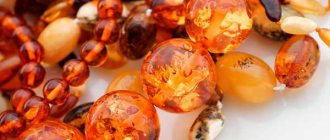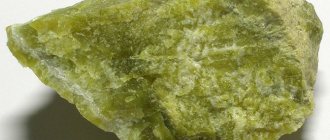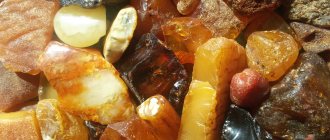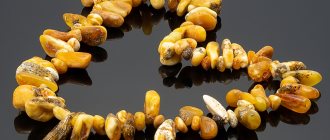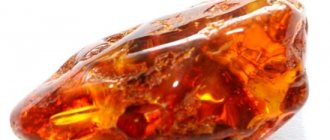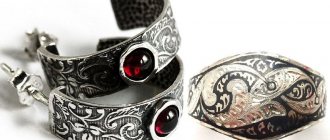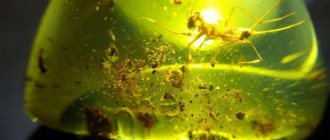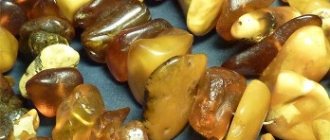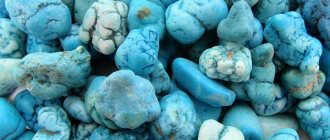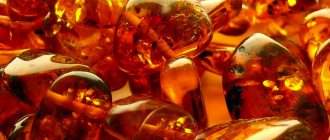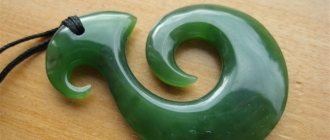Dominican amber
Why, upon its arrival in Europe, did this gem not gain popularity among the public? In fact, the Europeans already had Baltic amber. The development of those deposits fully fed the people. The "Sunstone" from Hispaniola came to attention only after the Second World War. Now it is also popular and is almost on the same level as Baltic amber.
Magic properties
Ancient people endowed the blue mineral with the ability to protect against evil spirits. It was often used in religious ceremonies. With the help of the stone, servants of ancient pagan cults tried to contact the spirits of the dead and influence the course of earthly events.
Our ancestors wore amber items on their chests. The mineral served them as a kind of amulet against troubles and misfortunes. It was believed that it absorbs bad energy and helps to remain calm, kind, and avoid quarrels. Blue amber protected children from bad people and helped them grow strong and healthy. It gave pregnant women the opportunity to safely bear their babies.
Features of Dominican amber
Each mineral has its own characteristics. So scientists are most interested in Dominican amber in its origin, because it is more than interesting. The types of this mineral and the methods of its extraction are intriguing. Only amber is characterized by such a feature as the preservation of living organisms inside the stone. This could be an insect or plant parts.
Origin
If a person could now travel back in time to about 20 - 40 million years ago, he would see dense forests in the Caribbean region. Attention should be paid to a special type of tree - Himenaea Protera. This is a plant from the legume family, which was actively dying out in those ancient times. When the tree received some kind of injury, it released resin. This is the future Dominican amber. Due to tectonic processes, trees along with the ground sank under water, where the resin hardened and turned into stone.
Amber mining
Unfortunately, due to the same plate movements and volcanic activity underwater, the reserves of the current Dominican amber are located in very inaccessible places. Nowadays, stone extraction is carried out exclusively by artisanal methods in small mines. The most popular deposits are located on the Amber Coast between Puerto Plata and Santiago.
Interestingly, small as yet undiscovered burial sites of Dominican amber are located on the northern coastal ridge of the Cordillera Septentrional. Moreover, their height varies from 500 to 1200 meters.
What does Dominican amber look like?
Most people think of amber exclusively as yellow or orange. In the case of Dominican amber, this opinion is wrong. There is a stone of different colors:
| Type of amber | a brief description of | Photo |
| Yellow-brown | The most popular variety, which is found in almost all mines. Most often, the stone is almost transparent; in its depths one can see particles of previously living organisms. | |
| Green | One of the rarest varieties. Scientists believe that the stone acquired this color due to the aquatic environment into which the resin fell. | |
| Blue or cyan | The rarest and, perhaps, the most famous type of Dominican amber. It is mined in only one mine in the world - La Cumbre. It is considered a very hard and expensive mineral. |
Inclusions (inclusions) of Dominican amber
According to statistics, 50 – 60% of amber found in the Dominican Republic is found with inclusion. These are inclusions of living organisms or their parts in the crystal lattice of the stone. Such cases occur exclusively with amber. How does this happen?
An ancient spider sat on the bark of a tree. A drop of resin approached him, which absorbed the body of the insect. Millions of years passed, the resin hardened and became amber, but the spider remained inside the stone.
Such phenomena are not just decoration, but also excellent material for science. In this way, scientists can study those living organisms that lived on our planet many millions of years ago. It is interesting that scientists have a unique opportunity to study not just a cast of the same insect, but its body in natural sizes. It is also worth considering that not only external organs are preserved, but also internal ones. The most famous finds:
- Arboreal small lizard;
- Chameleon 7 cm long;
- Big frog;
- A giant butterfly whose wingspan reached 126 centimeters;
- Remains of ancient flowers and extinct plants.
If we talk about the current fruits of studying this topic, then examples can be given endlessly. Thus, in the east of the island of Homa Mayor province, the remains of an ancient flower were found in amber. Scientists were able not only to study this fossil plant, but also to look into bygone eras. This is how the structure of the tropical forests, which disappeared from the island’s land millions of years ago, was restored. The reasons, the process of disappearance itself, and even the consequences were clarified. But it all started with a small flower.
How and where they mine
How and where it is mined
For the first time, the mining of the mineral began in the middle of the last century, when gold products ceased to be as relevant as before. During the first years, the government of the Dominican Republic was at a loss and did not understand the European interest in mining and such huge exports.
At the end of the 70s, a law was introduced according to which the export of jewelry from the country by foreigners was prohibited. A few years later, the law was amended and it was prohibited to export amber in any form, including those that contained the remains of animals and plants. To do this, it was necessary to obtain special permission from the Natural History Museum.
The main mining of the mineral is carried out in the Palo Kemalo mine. To do this, use the simplest device:
- scoops;
- pickaxes;
- shovels.
Some even search for stones by hand. Collapses often occur in mines and many seekers die.
Blue amber
As mentioned above, blue Dominican amber is the rarest and most expensive type of this mineral. It is mined in only one mine in the world. Presumably its age ranges from 15 to 30 million years.
Scientists believe that this shade appeared due to the mixing of tree resin, volcanic ash, and ocean water pressure. New shifts in tectonic plates occurred, and stone mining became available. The first Dominican blue amber was mined by the Indians, who made jewelry and figurines from it, and then gave several stones to Columbus.
What is the mystery of blue amber?
This amazing stone attracts the eye, shimmering with all shades of blue and blue, shining with white, yellow, red, green and even purple highlights!
But the most amazing and mysterious thing is the bluish glow of the Dominican stone, with which it glows under the influence of ultraviolet rays.
That is, if the stone lies in the shade or indoors, it has one shade, but once it is in the sun, you will see how it changes!
What is the reason for these amazing properties?
In the unique mineralogical composition that blue amber has, namely the presence of the substance “perylene” in the stone’s composition. Perylene is a chemical compound whose concentration affects the refractive spectrum of rays. Scientists explain the appearance of perylene by prolonged heating of hardening resin in an oxygen-free environment. The more perylene in amber, the richer the shade.
Benefits of Dominican amber
Even in ancient times, amber was called the “Sun Stone”. Dominican amber is no exception. People attributed a variety of properties to the mineral, for example:
- Anti-inflammatory effect on the body;
- Preservation of beauty;
- Rejuvenation;
- Antibacterial effect;
- Filling a person with strength and energy.
Similar properties were associated with the unusual color. Even treatment with amber was practiced. For example, small pieces of it were applied to inflamed or contaminated wounds, and they healed and cleaned faster. Since amber is the stone of the sun, it was credited with the property of being imbued with strength and energy in accordance with the nature of the star itself.
Amber also had esoteric abilities:
- Protection from evil and unkind spirits;
- Rescue from nightmares and bad dreams;
- Talisman and amulet for pregnant women and their children.
That is why not only jewelry was made from amber, but also unique amulets and figurines.
Astrologers also say that amber can be worn by people with the following zodiac signs:
- Scorpion;
- Aquarius;
- Cancer;
- Fish;
- Scales;
- Twins.
Sunstone structure
The structure of a sunstone
Since the origin of the stone is associated with the aquatic environment, it is not surprising that the outlines of the remains of a living organism can be traced inside the mineral. Contains inside:
- particles of animal and plant life;
- seaweed;
- fish teeth
For some time, the resin retained a soft shape, which was attractive to marine fauna. Many scientists are excited about the idea of extracting DNA and breeding dinosaurs and other representatives of the prehistoric period.
Dominican amber jewelry
Over the past 50 years, the stone has gained enormous popularity. It began to be actively used in jewelry. An interesting feature is the division of jewelry into two groups:
- Amber jewelry: the stone is inserted into the jewelry without cutting or setting.
- Jewelry with amber: the stone undergoes serious processing.
The most popular and recognizable are beads made from semi-processed stones. They are strung on a string, have different shapes and sometimes even colors.
Most often, amber is used in the manufacture of:
- Necklace;
- Seryozhek;
- Brooches;
- Bracelets;
- Coulombs;
- Rings.
Application
Of course, the main use of such a rare stone is the jewelry industry. A variety of jewelry is created from blue amber: earrings, beads, pendants and pendants, brooches, bracelets, rings, cufflinks, tie clips and many others.
In addition, various decorative and household items can be made from blue amber: dishes, coasters, figurines, chess, balls, combs, massagers, paintings and icons, souvenirs, rosaries, key rings, pens, etc.
The stone lends itself very well to processing and polishing, and therefore after all the manipulations it looks very beautiful.
Caring for Dominican Amber
Amber is not the hardest mineral. On the scale it has a value of 2.6. Therefore, handling it requires appropriate care.
- Jewelry should be protected from falls and impacts.
- Do not wash dishes or cook while wearing jewelry.
- You can wash the jewelry only with a soft cloth and under warm water.
- Jewelry should be stored away from other metals.
If you follow all these simple rules, then the jewelry will delight its owner for a long time.
How to distinguish an original from a fake?
Since amber has become very popular, there are many people who want to pass off a fake as a natural stone. That is why, when purchasing such a serious piece of jewelry, you need to carefully check its originality. You can use the following methods and tricks:
- If you wipe the fake with a cloth soaked in ether, the stone will become sticky.
- You can look at it through a magnifying glass. Dye stains may be visible.
- If you run a regular needle across natural stone, a scratch will definitely appear. There will be no trace left on the fake.
- If you put amber in salt water, it will float. The fake will sink.
- If you shine ultraviolet light on a natural mineral, you will get a bluish tint. The artificial stone is white.
SELECTION AND CARE
It is important to be able to distinguish unique exhibits so as not to fall for scammers.
Haitians perform various manipulations with amber first.
To avoid being the owner of plastic, you need to purchase jewelry from professionals and require certificates.
Cost and fakes
Jewelry art knows more malleable stones. Blue amber is quite hard, so only masters undertake its processing. The high cost of products is also associated with the rarity of the mineral and frequently occurring inclusions.
We recommend: What are the varieties and types of PEARLS?
Precious exhibits of private mineralogical collections are highly valued:
- Moscow is not the birthplace of blue amber, but jewelry with this stone can be found on the shelves of jewelry stores. A simple pendant will cost $300.
- Products with inclusions are more expensive: the price starts from $10,000.
- Specimens with inclusions contain not only insects, but also butterflies, frogs, and lizards.
You cannot purchase products at a very low cost:
- Fraudsters resort to such tricks as drilling into the stone and artificially placing insects in it.
- The hole is then filled with varnish and polished.
- Cabochons often appear on the shelves. The top of such products is covered with blue varnish, which adds to the price.
Cost of Dominican amber
The cost of Dominican amber depends on:
- Color range;
- The size of the stone itself;
- Degree of processing;
- Frame material;
- Presence of inclusions in stone.
However, Dominican amber itself is no less expensive, because the stone is quite rare. Let's present approximate prices depending on the frame:
- gold – 8000 – 42000 rubles;
- gilded silver – 3000 – 6000 rubles;
- silver – 1000 – 3000 rub.
You should not spare money on jewelry made from Dominican amber. Price is not just numbers, but sometimes a guarantee of quality. The interesting thing is that in the Dominican Republic itself, prices will be about half as much, especially if the mineral is not processed.
Facts from history
Blue amber is the youngest of all its varieties in origin. Scientists have determined that it is about 15 - 30 million years old. Europeans first learned about it at the end of the 15th century, when Columbus's expedition arrived in Haiti. Then, in a fit of gold rush, the stone, brought as a gift to travelers by local residents, was not paid due attention.
Residents of the Caribbean islands already in ancient times knew how to mine and process this mineral. They used it for ritual and medicinal purposes, as talismans and amulets. Particular interest in the stone arose in the second half of the 20th century, when the jewelry community realized the meagerness of the mined material and, consequently, its value.
